Janome Sewist 721 operation manual
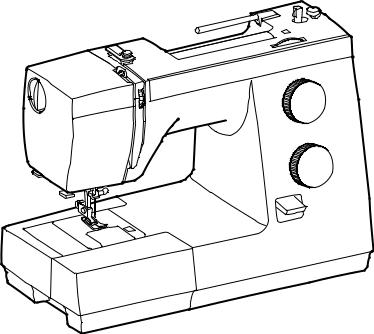
INSTRUCTION BOOK
IMPORTANT SAFETY INSTRUCTIONS
When using an electrical appliance, basic safety precautions should always be followed, including the following:
This sewing machine is designed and manufactured for household use only. Read all instructions before using this sewing machine.
DANGER— To reduce the risk of electric shock:
1.An appliance should never be left unattended when plugged in. Always unplug this sewing machine from the electric outlet immediately after using and before cleaning.
WARNING— To reduce the risk of burns, fire, electric shock, or injury to persons:
1.Do not allow to be used as a toy. Close attention is necessary when this sewing machine is used by or near children.
2.Use this appliance only for its intended use as described in this owner’s manual.
Use only attachments recommended by the manufacturer as contained in this owner’s manual.
3.Never operate this sewing machine if it has a damaged cord or plug, if it is not working properly, if it has been dropped or damaged, or dropped into water.
Return this sewing machine to the nearest authorized dealer or service center for examination, repair, electrical or mechanical adjustment.
4.Never operate the appliance with any air opening blocked. Keep ventilation openings of this sewing machine and foot controller free from accumulation of lint, dust and loose cloth.
5.Never drop or insert any object into any opening.
6.Do not use outdoors.
7.Do not operate where aerosol (spray) products are being used or where oxygen is being administered.
8.To disconnect, turn all controls to the off (“O”) position, then remove plug from outlet.
9.Do not unplug by pulling on cord. To unplug, grasp the plug, not the cord.
10.Keep fingers away from all moving parts. Special care is required around the sewing machine needle and/or cutting blade.
11.Always use the proper needle plate. The wrong plate can cause the needle to break.
12.Do not use bent needles.
13.Do not pull or push fabric while stitching. It may deflect the needle causing it to break.
14.Switch this sewing machine off (“O”) when making any adjustment in the needle area, such as threading the needle, changing the needle, threading the bobbin or changing the presser foot, and the like.
15.Always unplug this sewing machine from the electrical outlet when removing covers, lubricating, or when making any other adjustments mentioned in this owner’s manual.
SAVE THESE INSTRUCTIONS

For Europe only:
This appliance can be used by children aged from 8 years and above and persons with reduced physical, sensory or mental capabilities or lack of experience and knowledge if they have been given supervision or instruction concerning use of the appliance in a safe way and understand the hazards involved. Children shall not play with the appliance. Cleaning and user maintenance shall not be made by children without supervision.
For outside Europe (except U.S.A and Canada):
This appliance is not intended for use by persons (including children) with reduced physical, sensory or mental capabilities, or lack of experience and knowledge, unless they have been given supervision or instruction concerning use of the appliance by a person responsible for their safety. Children should be supervised to ensure that they do not play with the appliance.
Please note that on disposal, this product must be safely recycled in accordance with relevant National legislation relating to electrical/electronic products. If in doubt please contact your retailer for guidance. (European Union only)
TABLE OF CONTENTS
ESSENTIAL PARTS |
|
Names of Parts................................................. |
2 |
Standard Accessories....................................... |
3 |
Accessory storage .......................................... |
3 |
Extension Table ................................................ |
4 |
Free-arm sewing............................................. |
4 |
GETTING READY TO SEW |
|
Connecting the Power Supply .......................... |
5 |
Controlling the Sewing Speed .......................... |
5 |
Reverse Stitch Lever ........................................ |
6 |
Foot Pressure Dial............................................ |
6 |
Dropping the Feed Dog .................................... |
6 |
Raising and Lowering the Presser Foot ........... |
7 |
Changing the Presser Foot............................... |
7 |
Removing and Attaching the Foot Holder......... |
8 |
Changing Needles......................................... |
8-9 |
Needle and Thread Chart ................................. |
9 |
Winding the Bobbin ................................... |
10-12 |
Setting the spool........................................... |
10 |
Removing the bobbin.................................... |
10 |
Winding the bobbin....................................... |
11 |
Inserting the bobbin...................................... |
12 |
Threading the Machine.............................. |
13-14 |
Needle threader............................................ |
14 |
Drawing up the Bobbin Thread....................... |
15 |
Selecting the Stitch Pattern ............................ |
16 |
Stitch pattern selector dial ............................ |
16 |
Stitch Length Adjusting Dial....................... |
16-17 |
Adjusting stretch stitch balance .................... |
17 |
Stitch Width Adjusting Dial.............................. |
17 |
Variable needle position ............................... |
17 |
Balancing Needle Thread Tension.................. |
18 |
BASIC SEWING |
|
Straight Stitch Sewing ............................... |
19-20 |
Finishing sewing........................................... |
19 |
Changing the sewing direction ..................... |
19 |
Seam guides on the needle plate................. |
20 |
Turning a square corner ............................... |
20 |
UTILITY STITCHES |
|
Basic Zigzag................................................... |
21 |
Overcasting .................................................... |
21 |
Knit Stitch ....................................................... |
22 |
Tricot Stitch (Multiple Zigzag Stitch) ............... |
22 |
Straight Stretch Stitch..................................... |
23 |
Zigzag Stretch Stitch ...................................... |
23 |
Button Sewing ................................................ |
24 |
4-Step Buttonhole...................................... |
25-26 |
Corded Buttonhole.......................................... |
27 |
Zipper Application...................................... |
28-30 |
Blind Hemming ............................................... |
31 |
DECORATIVE STITCHES |
|
Smocking........................................................ |
32 |
Pin Tucking..................................................... |
33 |
Shell Tucking .................................................. |
33 |
Fagoting.......................................................... |
34 |
Patchwork....................................................... |
34 |
Appliqué.......................................................... |
35 |
Decorative Satin Stitches ............................... |
36 |
Decorative Stretch Stitches ............................ |
36 |
CARE AND MAINTENANCE |
|
Cleaning the Hook Race and Feed Dog......... |
37 |
Replacing the Bobbin Holder.......................... |
38 |
Troubleshooting......................................... |
39-40 |
1
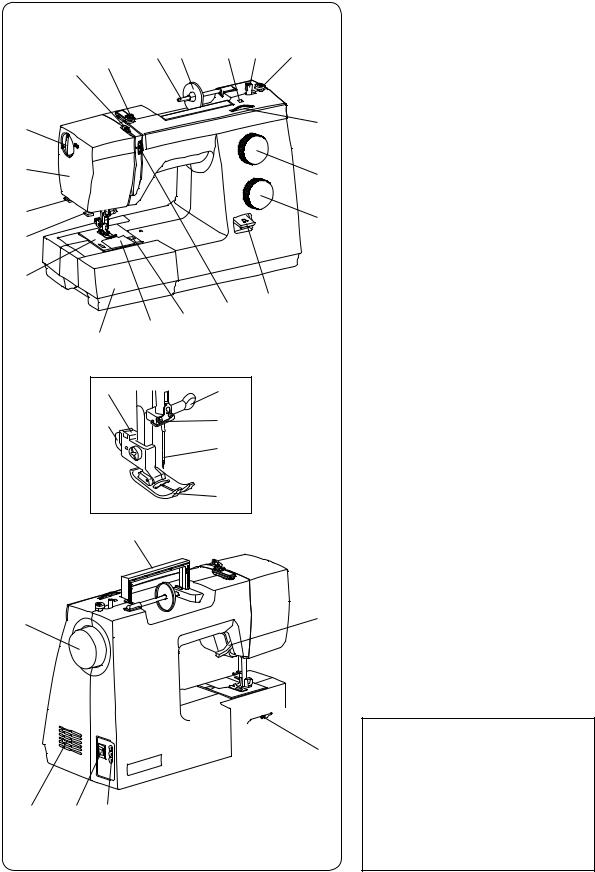
u y |
t r |
e w q |
|
|
|
i |
|
@0 |
|
|
|
o |
|
!9 |
|
|
|
!0 |
|
!8 |
|
|
|
!1 |
|
|
!2 |
|
|
|
!4 !5 |
!6 !7 |
!3 |
|
|
|
|
|
@5 |
|
@4 |
@6 |
|
@3 |
|
|
@2 |
@7 |
|
@1 |
|
|
|
@8 |
|
|
@9 |
#5 |

 #4
#4
#3
#0#1 #2
ESSENTIAL PARTS
Names of Parts
q Bobbin winder stopper w Bobbin winder spindle e Hole for extra spool pin r Spool holder
t Spool pin
y Bobbin winding tension disc u Thread take-up lever
i Foot pressure dial o Face plate !0Thread cutter !1Needle threader !2Needle plate
!3Extension table (Accessory storage) !4Hook cover plate
!5Hook cover plate release button !6Thread tension dial !7Reverse stitch lever
!8Stitch length adjusting dial !9Stitch pattern selector dial @0Stitch width adjusting dial @1Presser foot
@2Needle
@3Needle bar thread guide @4Needle clamp screw @5Foot holder
@6Lever @7Setscrew @8Carrying handle @9Handwheel
#0Ventilation openings #1Power switch #2Machine socket #3Drop feed lever #4Free-arm
#5Foot lifter
NOTE:
•To carry the sewing machine, hold the carrying handle with your hand, and support the sewing machine with the other hand.
•Design and specifications are subject to change without prior notice.
2
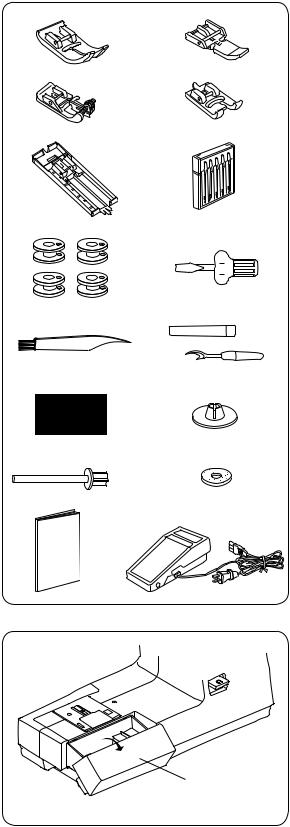
qw
er
t |
y |
u |
i |
o!0
!1 |
!2 |
!3 |
!4 |
!5 |
!6 |
q
Standard Accessories
q Zigzag foot A (set on the machine) w Zipper foot E
e Blind hemming foot G r Buttonhole foot B
t Sliding buttonhole J y Needle set
u Bobbin x4 (1 set on the machine) i Screwdriver
o Lint brush
!0Seam ripper (buttonhole opener) !1Spool holder (large) (set on the machine) !2Spool holder (small)
!3Extra spool pin !4Felt cushion !5Instruction book !6Foot control
*The foot control included may differ from the illustration.
Accessory storage
Accessories are stored the extension table. Pull lid towards you to open the accessory storage.
q Accessory storage
3
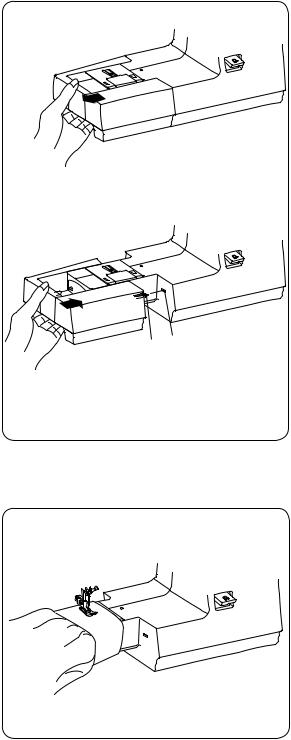
Extension Table
To detach:
Pull the extension table to the left.
To attach:
Push the extension table, inserting the tab into the slot until the table snaps into the machine.
q Tab
w Slot
q w
Free-arm sewing
Free-arm sewing is used for stitching sleeves, waistbands, pant legs or any other tubular garments.
It is also useful for darning socks or mending knees or elbows.
4

|
|
GETTING READY TO SEW |
|
|
Connecting the Power Supply |
|
|
z Turn the power switch off. |
q |
r |
x Insert the machine plug into the machine |
|
|
socket. |
|
|
c Insert the power supply plug into the wall |
|
|
outlet. |
tv Turn the power switch on.
|
|
q Power switch |
|
|
|
w Machine plug |
|
|
|
e Machine socket |
|
|
|
r Power supply plug |
|
|
w |
t Wall outlet |
|
e |
NOTE: |
||
|
|||
|
|
Before connecting to the power supply, make |
|
|
|
sure the voltage shown on the machine |
|
|
|
conforms to your electrical power. |
WARNING:
While in operation, always keep your eyes on the sewing area, and do not touch any moving parts such as the thread take-up lever, handwheel or needle.
Always turn off the power switch and unplug from the power supply:
- when leaving the machine unattended. - when attaching or removing parts.
- when cleaning the machine.
Do not place anything on the foot control, otherwise the machine will run intermittently.
Controlling the Sewing Speed
Foot control
Sewing speed can be varied by the foot control.
The harder you depress the foot control, the faster the machine runs.
Operating Instructions:
The symbol “O” of a switch indicates the “off” position of a switch.
For the U.S.A. and Canada only:
For an appliance with a polarized plug (one blade wider than the other):
To reduce the risk of electrical shock, this plug is intended to fit in a polarized outlet only one way. If it does not fit fully in the outlet, reverse the plug. If it still does not fit, contact a qualified electrician to install the proper outlet. Do not modify the plug in any way.
The foot controller Model YC-482J or YC-168S is used with this sewing machine. 5
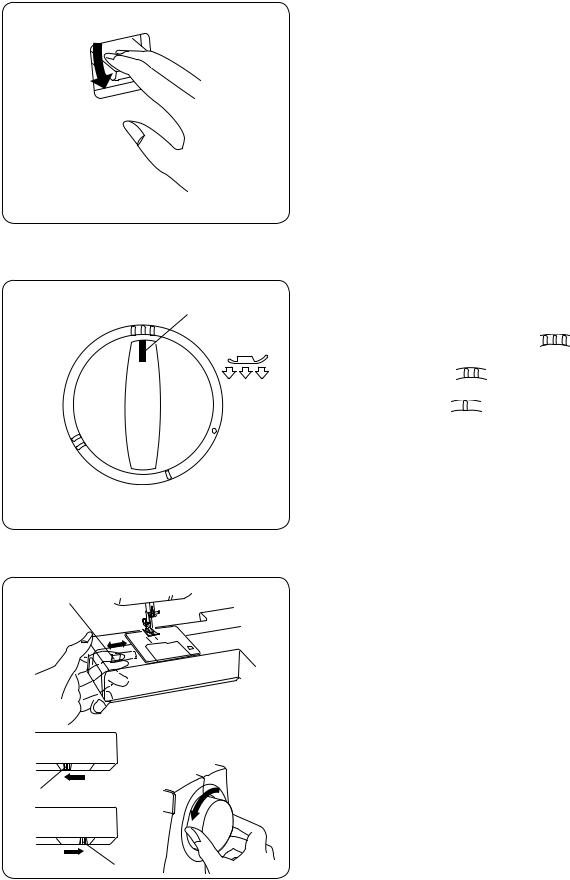
Reverse Stitch Lever
Push the reverse stitch lever down to sew in reverse.
The machine will sew in reverse while the lever is pushed.
Foot Pressure Dial
q |
Turn the foot pressure dial to adjust the foot |
|
|
|
pressure. |
|
|
|
The foot pressure dial should be set at “ |
” (3) |
|
|
for regular sewing. |
|
|
|
Reduce the pressure to “ |
” (2) for appliqué, |
|
|
cutwork, drawn work and basting. |
|
|
|
Set the setting mark at “ |
” (1) when sewing |
|
|
chiffon, lace, organdy and other fine fabrics. |
|
|
|
q Setting mark |
|
|
q |
Dropping the Feed Dog |
|
The drop feed lever is located underneath the |
||
|
||
|
free-arm bed on the backside of the machine. |
|
|
To drop the feed dog, push the lever in the |
|
|
direction of the arrow w, as illustrated. |
To raise the feed dog, push the lever in the direction of the arrow e, as illustrated, and turn the handwheel toward you.
|
The feed dog must be up for regular sewing. |
w |
q Drop feed lever |
|
w Lowered position |
|
e Raised position |
e
6
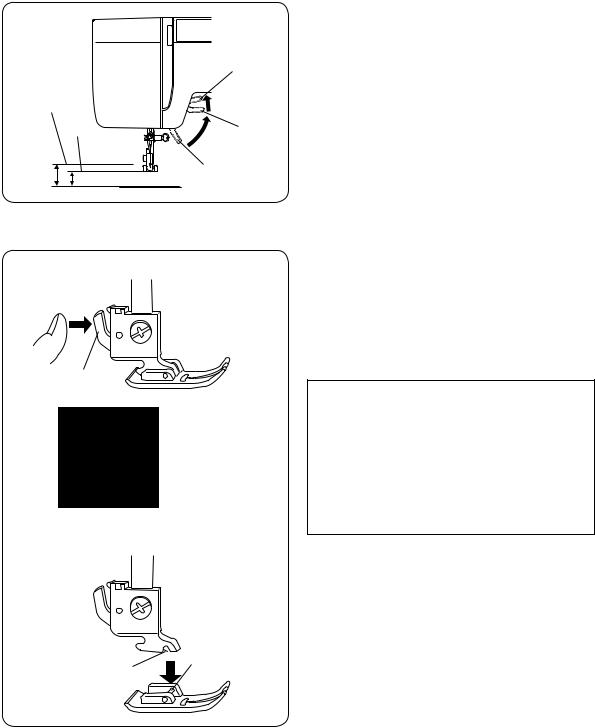
Raising and Lowering the Presser Foot
The presser foot lifter raises and lowers the presser foot.
eYou can raise the foot about 1/4˝ (0.6 cm) higher than the normal up position for easy removal
e |
|
of the presser foot, or to help you place heavy |
w |
w |
fabric under the foot. |
|
|
q Lowered position |
|
q |
w Normal up position |
|
e Extra up position |
|
|
|
Changing the Presser Foot
To remove:
Raise the needle to its highest position by
turning the handwheel counterclockwise. Raise the presser foot, and press the lever on the back of the foot holder.
q Lever
q
 CAUTION:
CAUTION:
Turn OFF the power switch before changing the foot.
Always use the proper foot for the selected
pattern.
The wrong foot can cause the needle to break.
Do not push the lever down to prevent it from being broken.
|
|
To attach: |
|
|
Place the desired presser foot, so that the pin |
|
|
on the foot lies just under the groove on the foot |
|
|
holder. Lower the presser foot lifter to lock the |
|
|
foot in place. |
|
|
w Groove |
w |
e |
e Pin |
|
|
7
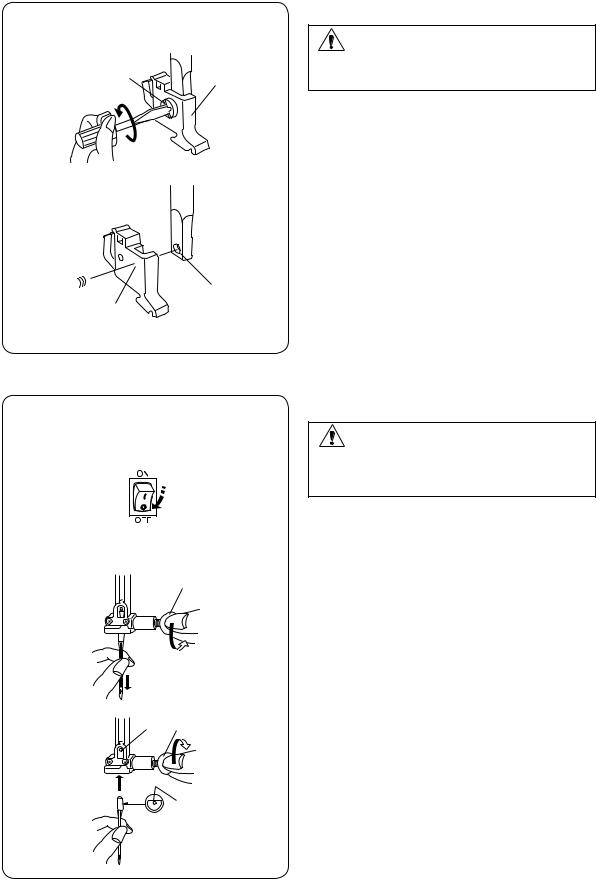
q w

 r e
r e
z q
x |
e q |
|
w |
Removing and Attaching the Foot Holder
WARNING:
Turn OFF the power switch before detaching or attaching the foot holder.
To remove:
Remove the setscrew by turning it counterclockwise with a screwdriver and remove the foot holder.
To attach:
Match the hole in the foot holder with the threaded hole in the presser bar. Fit the setscrew into the hole. Tighten the screw by turning it clockwise with a screwdriver.
q Setscrew w Foot holder e Hole
r Threaded hole
Changing Needles
CAUTION:
Always make sure to turn the power switch off and disconnect the machine from power supply before changing the needle.
Raise the needle by turning the handwheel and lower the presser foot.
Turn off the power switch.
zLoosen the needle clamp screw by turning it counterclockwise.
Remove the needle from the clamp. q Needle clamp screw
x Insert a new needle into the needle clamp with the flat side of the needle to the rear.
When inserting the needle into the needle clamp, push it up against the stopper pin and tighten the needle clamp screw firmly.
q Needle clamp screw w Flat side
e Stopper pin
8
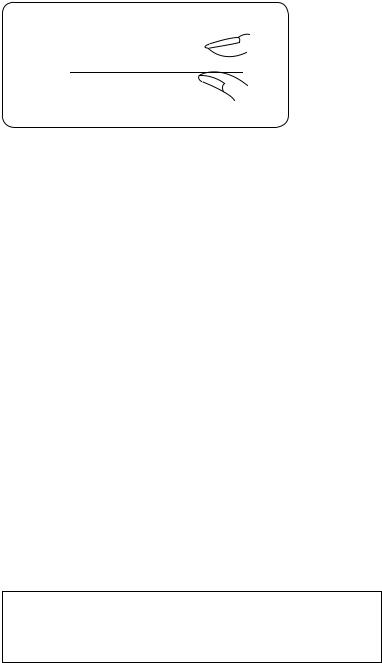
r 



Needle and Thread Chart
To check needle straightness, place the flat side of the needle onto something flat (a needle plate, glass etc.) The gap between the needle and the flat surface should be consistent.
Never use a blunt needle. r Gap
•For general sewing, use needle size 11/75 or 14/90.
•A fine thread and needle should be used for sewing lightweight fabrics, so the fabric will not be marred.
•Heavy fabrics require a needle large enough to pierce the fabric without fraying the needle thread.
•Always test the needle size on a small scrap of the fabric that will be used for actual sewing.
•In general, use the same thread for the needle and bobbin.
•When sewing stretch fabrics, very fine fabrics and synthetics, use a blue tip needle.
•The blue tip needle effectively prevents skipped stitches.
|
Fabric |
Thread |
Needle |
|
|
|
Lawn |
|
|
Fine |
|
Georgette |
Silk #80-100 |
#9/65-11/75 |
|
Tricot |
Cotton #80-100 |
||
|
Blue tip needle |
|||
|
|
Organza |
Synthetic #80-100 |
|
|
|
|
||
|
|
Crepe |
|
|
|
|
Sheeting |
Silk #50 |
|
Medium |
|
Jersey |
|
|
|
Cotton #50-80 |
#11/75-14/90 |
||
|
|
Broadcloth |
Synthetic #50-80 |
|
|
|
Fleece |
|
|
|
|
|
|
|
Heavy |
|
Denim |
Silk #30-50 |
|
|
Tweed |
|
||
|
Cotton #40-50 |
#14/90-16/100 |
||
weight |
|
Coating |
||
|
Synthetic #40-50 |
|
||
|
|
Quilting |
|
|
|
|
|
|
|
NOTE:
1 x blue tip needles (#11/75), 2 x #11/75 needles and 2 x
#14/90 needles are included in the needle case (Part No. 540401026).
9
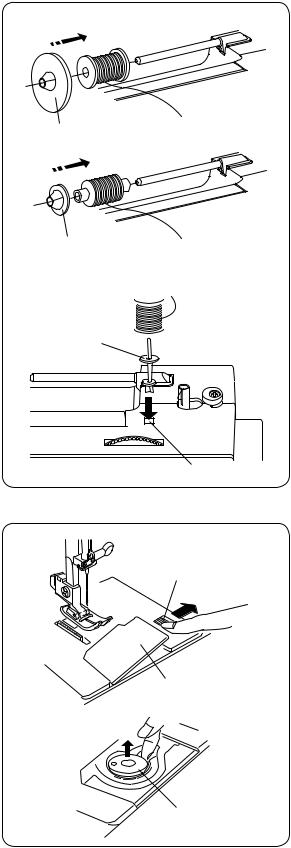
(A)
q
(B)
w
r e
e
t
z
q
w
x
e
Winding the Bobbin
Setting the spool
Place a spool of thread on the spool pin with the thread coming off the spool as illustrated.
A:Press the large spool holder firmly against the spool of thread.
q Large spool holder
B:For a small spool, use the small spool holder. w Small spool holder
Extra spool pin
The extra spool pin is for bobbin winding without unthreading the machine.
Insert the extra spool pin into the hole. Place the felt and a spool on the pin.
e Extra spool pin r Spool pin felt t Spool pin hole
Removing the bobbin
zPush the hook cover plate release button to the right and remove the cover plate.
q Hook cover plate release button w Hook cover plate
x Lift out the bobbin.
e Bobbin
10
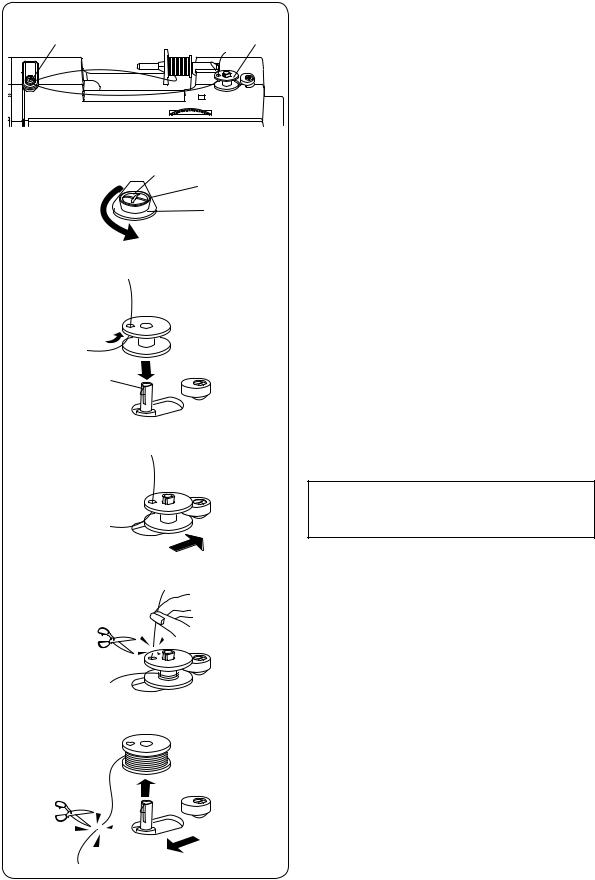
Winding the bobbin
q |
w |
|
q |
z |
z Draw the thread from the spool. Guide the |
|
thread around the bobbin winding tension |
|
disc. |
|
q Bobbin winding tension disc |
x |
x Thread through the hole in the bobbin from |
|
the inside to the outside. |
|
Put the bobbin on the bobbin winder spindle |
|
with the free end of the thread coming out at |
|
the top. |
|
w Bobbin winder spindle |
w
c |
c Push the bobbin to the right. |
NOTE:
Do not move the bobbin winder spindle while the machine is running.
v |
v With the free end of the thread held in your |
|
hand, depress the foot control. Stop the |
|
machine when the bobbin has been wound |
|
a few layers, and cut the thread close to the |
|
bobbin. |
b |
b Depress the foot control again. When |
|
the bobbin is fully wound, it will stop |
|
automatically. |
|
Return the bobbin winder to its original |
|
position by moving the spindle to the left, and |
|
cut the thread as illustrated. |
11
